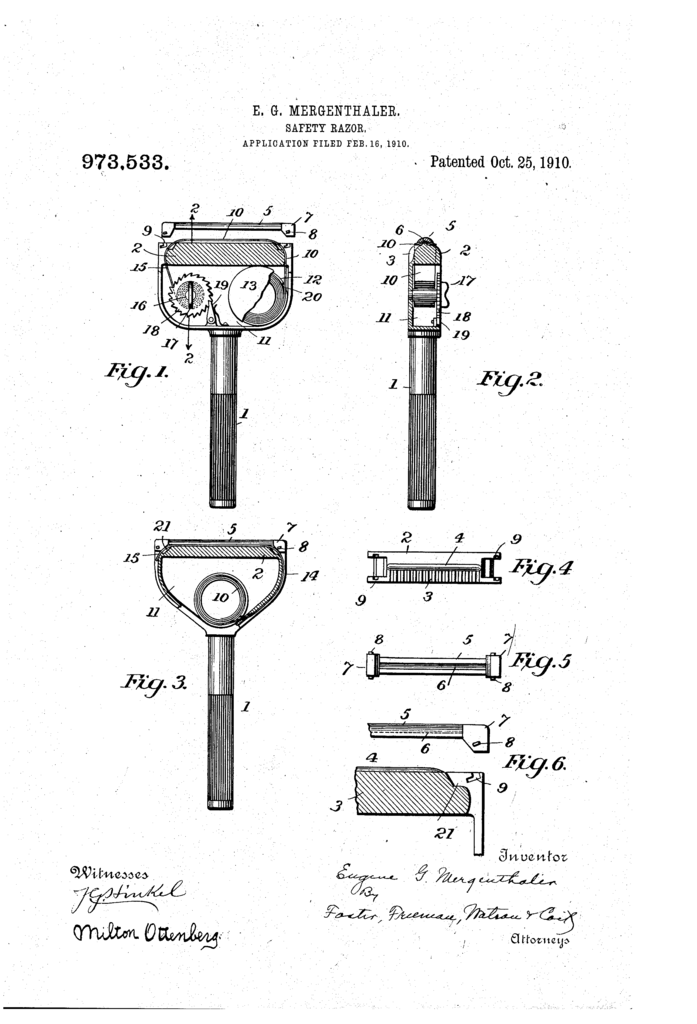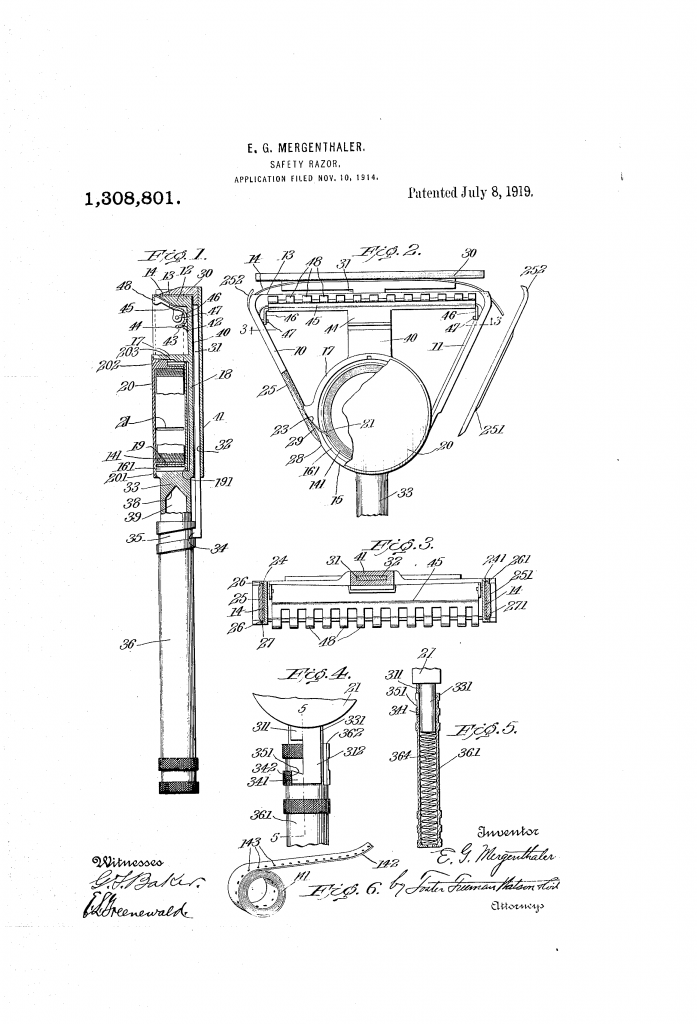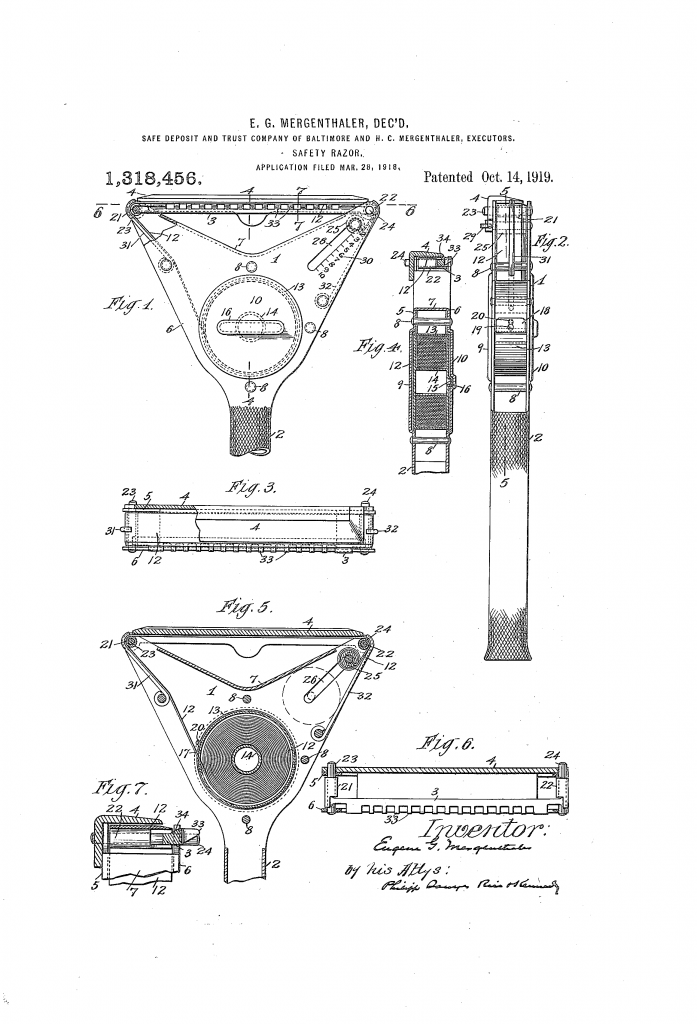Eugene G Mergenthaler was the son of an inventor,1 and it was perhaps naturally that he tried his hand on inventing himself. While Eugene died young,2 he never the less had three patents to his name. One patented in 1910, when he was just 25 years old, and two more in patented in 1919.
Common to all three patents is the fact that they are band razors. This is a kind of razor that was dreamt up early and then refused to die. Well, at least until cartridges made their debut. The last band razors I’m aware of were the Schick Auto-Band Razor and the Gillette TechMatic.4
The three patents shares some similarities. As mentioned, they are all band razors. They all feature a spool of razor blade, as well as a way to clamp the blade securely. There are other similarities too, making it obvious that this is a design that was tinkered with for years.
First patent from Eugene G Mergenthaler
The first patent, US patent number 973,533, was filed in 1910 and granted the same year. As always, it was claimed to be a useful improvement on the state of art. I suspect there is a requirement to be an improvement in order to file a patent. To quote the rationale of the invention from the patent text:
One of its principal objects is to avoid the inconvenience incident to removing one short blade and inserting another when the first blade becomes dull from use, as is customary at present. To this end I have provided a blade which may be retained in the frame in the shape of a continuous band wound into a coil so that it may be drawn progressively across the shaving portion of the frame, presenting new cutting edges for the purpose of shaving, without removing the blade from the frame.
From US patent 973,533
There are two variations on the design outlined in the patent text and drawings. One has a ratcheted take up spool (fig 1) the other requires the user to advance the blade by hand (fig 3). In the later variation the excess blade is simply broken off and discarded. Both variations are depicted in the drawing. The main difference – apart from the ratchet – was the shape of the head and the routing of the blade.

To quote from the text again:
In the form shown in Fig. 1 the blade passes up directly to the cutting portion within the margin of the main frame, and in the form shown in Fig. 3 it passes up around the casing between the side flanges 14 which protect the edge. The blade is drawn across the guard portion 2 by a pull on the end 15, and this pull may be exerted by hand as in the form shown in Fig. 3 or by any suitable mechanism within the casing. In the form shown in Fig. 1 I make use of a winding drum 16 to which the free end 15 is attached, this drum being turned by a thumb piece 17 and being prevented from reverse rotation by the ratchet wheel 18 and spring pawl 19. This winding drum not only pulls the blade across the guard portion so as to present a new cutting section in operative position and unwinding the coil within the cylindrical casing 12, but it disposes of the free used end of the blade without destroying or discarding it. When the entire length of the cutting blade has been used and wound on the drum 16, it may be removed and sharpened so as to be used again if desired.
From US patent 973,533
I find it interesting that the idea of recycling – that it, resharpening – of the razor blade band was considered. It is worth remembering that Gillette offered money back on used blades back then. In theory, at least, resharpening a blade5 will save on resources and cost. In reality… well, shipping back and forth, cleaning, repackaging, inspection… it probably is not cost efficient to do at an industrial scale.6
Mergenthaler’s second and third patent
Eugene filed two more patents for band razors. Both shows rather similar razors, and both were granted in 1919 – after the inventors early death.
The first one, filed in 1914, was a refinement of the second variation of his first patent. The shape of the head was improved, a plunger kept the roll of blade from unrolling, and the shaver still had to break of the used portion of the blade. Of interest was also the way the blade was perforated at regular intervals. To quote:
As shown in Figs. 1, 2 and 6 the coil of razor tape 141 is composed of a narrow band of thin flexible steel having a cutting edge 142 co-extensive therewith and is wound so that the coil will have a hollow center whereby it will fit around the stud 19 and tend to spring against the side wall of the magazine. It will be seen that the tape is perforated at intervals in its length, which perforations 143 have a two-fold function. They weaken the blade at intervals so that when the used part is withdrawn to be snapped off and thrown away it will break at the weakened portions, that is, at a point where the blade is perforated and therefore it is but necessary to bend the blade upwardly at a perforated section to break it off. In withdrawing the blade the perforated parts provide a grip whereby the perforated blade may be more readily withdrawn than a smooth one. The perforations may in fact be utilized to receive a pin or hook of some kind, whereby the blade may be drawn out of the magazine over the blade supporting surface, without danger of cutting the fingers.
From US patent 1,308,801

Just how the coil of blade could be waterproofed is a little unclear. Perhaps a rubber gasket of some sort could have been worked into the design, because the slot shown at 29 would have let some water in no matter how narrow it was.
Eugene’s last patent was filed the year before he died. It shows a razor looking very much like his second patent, but going back to the idea of rolling up the used blade on a take up roller inside the head of the razor. The ratched was gone, instead the tension seem to have been kept by friction. The take up roller itself could slide up and down, and would indicate how much of the roll was used up. To quote once again:
Roller 25 is mounted, so as to turn and slide downwardly therein, in a downwardly and inwardly inclined slot 28 in the walls 5, 6 of holder 1. It is also provided with a thumb piece 29 extending outside the holder 1 whereby it may be conveniently turned to draw strip 12 through the holder and bring blade sections thereof successively into shaving position on blade support 3. As the strip 12 accumulates on take-up roller 25, and the diameter of the latter with its convolutions of strip therefore increases, roller 25 will move downwardly in slot 28 and also inwardly away from the edge of holder 1 so as to avoid contact of the strip 12 with and possible injury by it to the hands of the user. The opposite edge of holder 1 also projects beyond the path of movement of strip 12 for the same reason.
From US patent 1,318,456
Holder 1 is provided with a scale or index 30 for indicating when successive blade sections are brought into shaving position and also how many have been used. The indicating capacity of the scale as shown is limited to ten blade sections, but this may obviously be increased according to the number of blade sections desired or provided in strip 12.

It is a little unclear to me just how well the moving take up roller would have worked. If it was too much friction between the strip of blade and the sidewalls, it would be hard to turn the tiny thumb piece. Not enough, and there wouldn’t be enough tension to keep the blade secure.
Ruminations on Mergenthaler’s razors
To us, the various band razors may look like mechanical monstrosities. At least when we compare them to the mechanical simplicity of a Gillette Old or an EverReady 1914. But it is worth keeping in mind that the razors of Eugene G Mergenthaler – and later band razors – was trying to solve a problem that perhaps didn’t exists.7 Reading his patents, he consistently refers to his razors as magazine safety razors. That is, a safety razor that had a magazine of blades ready to go. A razor a shaver could easily and painlessly get a new cutting surface on.
This also explains, I feel, why ideas for band razors finally died away when cartridge razors showed up – they were two different solutions to the same non-problem; how to change a razor blade easily.
You can read the full text of the patents of Eugene G Mergenthaler at Google Patents and also at razors.click.
US 973,533: Google Patents / razors.click
US 1,308,801: Google Patents / razors.click
US 1,318,456: Google Patents / razors.click
Footnotes
- He was the son of Ottmar Mergenthaler, inventor of the hot metal typesetting Linotype machine. An interesting device in it’s own right, but outside the scope of this blog.
- Eugene G Mergenthaler was only 34 years old when he died of pneumonia.3 Given that he died on 4th of January 1919, it is likely that he was a victim of the Spanish Flu.
- When Eugene died, he bequeathed 200,000 dollars to the John Hopkins University. The sum was meant to either fund a library or a new science building. The resulting Mergenthaler Hall is now the home of the economics, sociology, art history, and political science departments at John Hopkins.
- Which, interestingly enough, were the basis for a patent on rechargeable vibrating razors back in ’71.
- Be it individual double or single edged blades, or a long band of blade.
- At home would be a different matter, as proven by the wide range of razor blade sharpeners available for the frugal shaver.
- And which frankly, don’t really exists today either.
